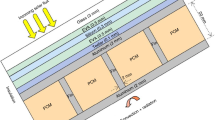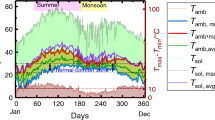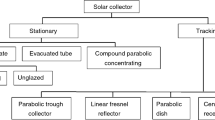Abstract
The space heating in residential buildings during winters account for a considerable amount of conventional or high-grade electrical energy. Therefore, improving the performance of space heating systems with the inclusion of renewable energy sources like solar becomes crucial in order to have better occupant’s comfort while reducing energy use. Phase change material (PCM) is one of the best solutions for the storage of renewable thermal energy, especially solar, which are intermittently available. PCM stores energy when surplus energy is available and deliver whenever it is required. It can be integrated with the system for energy storage as well as availing heat at a constant temperature. The present study will try to demonstrate the energy-saving by implementing the local heating with a spiral latent heat thermal energy storage system, when only a particular (local) space heating is of interest. In this work, an experimental, as well as the numerical studies of a dome over a bed were performed. Various heating coil configurations, namely floor coil, roof zig-zag, and roof spiral, were constructed to find the best configuration for the localized space heating. Experiments and simulations with the variable flow rate (0.25, 0.50, and 0.75 m/s) and varying inlet temperatures (55, 60, and 65 °C) of the heat transfer fluid were carried out. It was found that the floor coil heating gives better results as compared with the other two. It was also seen that the effect of mass flow rate and inlet temperature was not that much significant after a limit. A temperature difference of 20 °C was maintained between the space under consideration with the surrounding room.














Similar content being viewed by others
Data availability
All data pertaining to this research work is available in the manuscript.
Abbreviations
- CFD:
-
Computational Fluid Dynamics
- HEX:
-
Heat Exchanger
- HTF :
-
Heat Transfer Fluid
- LHTESS:
-
Latent Heat Thermal Energy Storage System
- PCM:
-
Phase Change Material
- ETC:
-
Evacuated Tube Collector
- C p :
-
Specific heat capacity at constant pressure (J/kg.K)
- h :
-
Enthalpy (J/kg)
- k :
-
Thermal conductivity (W/m.K)
- p :
-
Pressure (N/m2)
- S :
-
Source (J)
- T :
-
Temperature (K)
- U :
-
Velocity (m/s)
- α :
-
Volumetric expansion coefficient (1/K)
- μ :
-
Dynamic viscosity (Pa·s)
- ρ :
-
Density (kg/m3)
- τ :
-
Shear stress (N/m2)
References
Pérez-Lombard L, Ortiz J, Pout C (2008) A review on buildings energy consumption information. Energy Build40(3). https://doi.org/10.1016/j.enbuild.2007.03.007
Behzadi S, Farid MM (2011) Experimental and numerical investigations on the effect of using phase change materials for energy conservation in residential buildings. HVAC R Res 17(3):366–376. https://doi.org/10.1080/10789669.2011.573052
Meng E, Yu H, Zhan G, He Y (2013) Experimental and numerical study of the thermal performance of a new type of phase change material room. Energy Convers Manag 74:386–394. https://doi.org/10.1016/j.enconman.2013.06.004
Farid MM, Behzadi S (2010) Energy storage for efficient energy utilization in buildings. 1st Int High Perform Build Conf pp. 12–15
Waqas A, Kumar S (2013) Phase change material (Pcm)-based solar air heating system for residential space heating in winter. Int J Green Energy 10(4):402–426. https://doi.org/10.1080/15435075.2012.673518
Berroug F, Lakhal EK, El Omari M, Faraji M, El Qarnia H (2011) Thermal performance of a greenhouse with a phase change material north wall. Energy Build 43(11):3027–3035. https://doi.org/10.1016/j.enbuild.2011.07.020
Tyagi VV, Pandey AK, Kothari R, Tyagi SK (2014) Thermodynamics and performance evaluation of encapsulated PCM-based energy storage systems for heating application in building. J Therm Anal Calorim 115(1):915–924. https://doi.org/10.1007/s10973-013-3215-z
Tyagi VV, Buddhi D, Kothari R, Tyagi SK (2012) Phase change material (PCM) based thermal management system for cool energy storage application in building: An experimental study. Energy Build 51:248–254. https://doi.org/10.1016/j.enbuild.2012.05.023
Quanying Y, Zhenbang R, Lihang Y (2015) Applied research on hot water heating wallboard with phase-change material. Int J Sustain Energy 34(5):298–309. https://doi.org/10.1080/14786451.2013.824878
Jin X, Zhang X (2011) Thermal analysis of a double layer phase change material floor. Appl Therm Eng 31(10):1576–1581. https://doi.org/10.1016/j.applthermaleng.2011.01.023
Huang K, Feng G, Zhang J (2014) Experimental and numerical study on phase change material floor in solar water heating system with a new design. Sol Energy 105:126–138. https://doi.org/10.1016/j.solener.2014.03.009
Dubovsky V, Ziskind G, Letan R (2014) Effect of windows on temperature moderation by a phase-change material (PCM) in a structure in winter. Energy Convers Manag 87:1324–1331. https://doi.org/10.1016/j.enconman.2014.04.007
Biswas K, Lu J, Soroushian P, Shrestha S (2014) Combined experimental and numerical evaluation of a prototype nano-PCM enhanced wallboard. Appl Energy 131:517–529. https://doi.org/10.1016/j.apenergy.2014.02.047
Halawa E, Saman W (2011) Thermal performance analysis of a phase change thermal storage unit for space heating. Renew Energy 36(1):259–264. https://doi.org/10.1016/j.renene.2010.06.029
McElroy JA, Newcomb PA, Trentham-Dietz A, Hampton JM, Kanarek MS, Remington PL (2002) Endometrial cancer incidence in relation to electric blanket use. Am J Epidemiol 156(3). https://doi.org/10.1093/aje/kwf020
Lof GOG (1977) Systems for space heating with solar energy. Appl Sol Energy Heat Cool Build
Shukla PK, Kishan PA (2019) CFD Analysis of Latent Heat Energy Storage System with Different Geometric Configurations and Flow Conditions. In Proceedings of the 25th National and 3rd Int ISHMT-ASTFE Heat Mass Transf Conf (IHMTC-2019). https://doi.org/10.1615/IHMTC-2019.420
Shukla PK, Kishan PA (2021) Effect of input parameters on energy requirements of phase change material integrated local heating system. J Phys Conf Ser 2116(1):012083. https://doi.org/10.1088/1742-6596/2116/1/012083
Shukla PK, Kishan PA (2022) Solar Thermal Energy Storage with Phase Change Material for Domestic Active Space Heating Applications. In Proceedings of 5th Int Symposium Convective Heat Mass Transf(CONV-22). https://doi.org/10.1615/ICHMT.2022.CONV22.460
ANSYS Inc. (2017) ANSYS Fluent Theory Guide User’s Guide, Release 18.1
ANSYS Inc. (2017) ANSYS Fluent User’s Guide, Release 18.1
Acknowledgements
Authors acknowledge the financial support provided by the Science and Engineering Research Board (SERB), Department of Science and Technology (DST), Govt. of India, through grant ECR/2015/00526, and project titled ‘Solar Energy Storage Using Phase Change Materials for Space Heating Applications’.
Author information
Authors and Affiliations
Contributions
Pushpendra Kumar Shukla: Conceptualization, Methodology, Experiments, Simulations, Writing—original draft, Data curation, Investigation. P. Anil Kishan: Conceptualization, Supervision, Writing—review & editing.
Corresponding author
Ethics declarations
Conflict of interest
The authors declare there is no conflict of interest.
Additional information
Publisher's Note
Springer Nature remains neutral with regard to jurisdictional claims in published maps and institutional affiliations.
Rights and permissions
Springer Nature or its licensor (e.g. a society or other partner) holds exclusive rights to this article under a publishing agreement with the author(s) or other rightsholder(s); author self-archiving of the accepted manuscript version of this article is solely governed by the terms of such publishing agreement and applicable law.
About this article
Cite this article
Shukla, P.K., Kishan, P.A. Effect of input parameters on energy requirements of phase change material integrated local heating system: a case study. Heat Mass Transfer (2022). https://doi.org/10.1007/s00231-022-03321-z
Received:
Accepted:
Published:
DOI: https://doi.org/10.1007/s00231-022-03321-z




